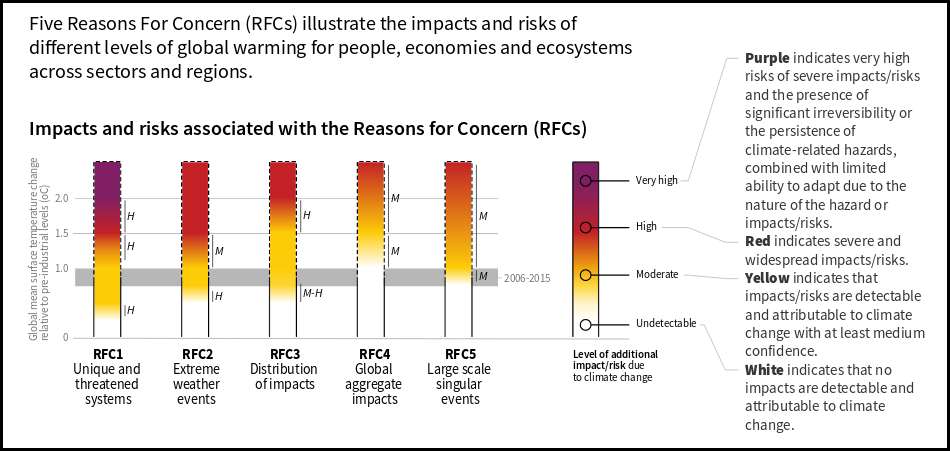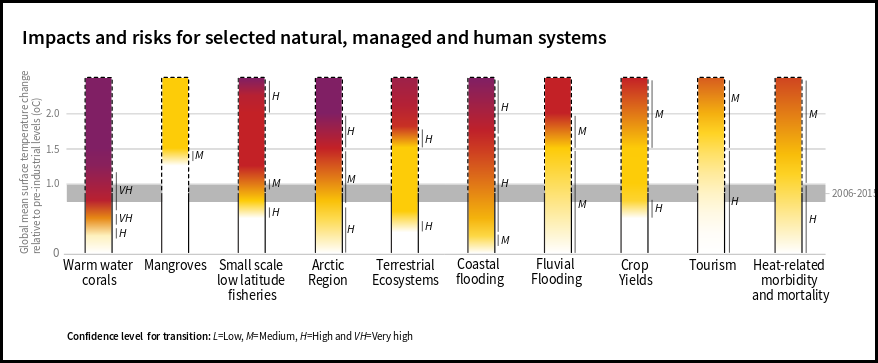Our internationally agreed targets of limiting global warming to 2.0 degrees are not good enough – and we weren’t meeting them anyway. The IPCC says the evidence is we need to keep to below 1.5 degrees, which we could hit by 2030. This blog explains the news in detail.
What’s the news
This news comes from the latest report by the The Intergovernmental Panel on Climate Change (IPCC), which was founded by the United Nations and Word Meteorological Organisation. The IPCC reviews and assesses research, rather than undertakes it.
A bullet point summary
- Humans have already caused a 1 degree rise in global temperatures.
- This is already affecting our planet and will continue to affect it for centuries, even millennia, to come.
- A rise of 1.5 degrees and a slower rise is, in very practical ways, less dangerous than 2 degrees or a faster rise.
- There will be less of all the worst things – for example extreme heat-waves, droughts, rainfall and flooding
- Conversely, there is good evidence that limiting warming to 1.5 degrees rather than 2 will have benefits:
- Risks to human and animal health will be less
- Ecosystems will be more likely to survive
- Global poverty would be alleviated in the process
- Rapid and far-reaching changes in energy, land, housing and infrastructure are needed to achieve a 1.5 target
- Our current targets, from e.g. the Paris Agreement would not limit us to 1.5 degrees
- International cooperation is vital and it is possible for us to achieve this aim if we work together.
A visual summary of the dangers
In the charts below you can see the predicted impacts for 1, 1,5 and 2 degree rises:


Impacts today – 1.0 degree
The grey box running horizontally represents now – a 1.0 degree rise. We are already experiencing extreme weather events and some large scale singular events attributable to climate change, for example ice sheets disintegrating. Indigenous people in e.g. the Arctic are affected. Coral reefs, glaciers and biodiversity are threatened. We are experiencing coastal flooding and crop yields are affected. Climate change is just starting to “cost” the whole world, both financially and in terms of biodiversity.
Impacts in 2030-2015 – 1.5 degrees
Above 1 degree is a thin, grey horizontal line representing 1.5 degrees. At 1.5 degrees there will be a widespread, severe risk of extreme weather events and additional large scale events. There will be a more widespread severe risk to indigenous people and ecosystems. We will experience severe coital flooding and beginning to experience river flooding. The whole world will lose money and biodiversity at a faster rate. We will see heat related deaths which can be attributed specifically to climate change.
Why we need to stop before 2.0 degrees
The final line, near the top of the chart is for 2 degrees – the current international target. We will see severe implications and risks for indigenous peoples in unique climates and significant and irreversible damage to the Arctic, ecosystems, glaciers and coral reefs. We will experience severe are widespread extreme weather, extreme coital flooding, severe river flooding and our crop yields will be severely impacted in a widespread way. There will be sudden t and severe large scale events with high risks. The world will be poorer and the financial cost will be more severe. There will severe and widespread risk of heat related death or disablement.
Further information
- Audio: Interview with Solitaire Townsend on PM, at 22mins in. (Link broken so we removed it)
- Written: The IPCC report in full

One thought on “Global Warming: what’s the difference between 1.5 and 2 degrees?”